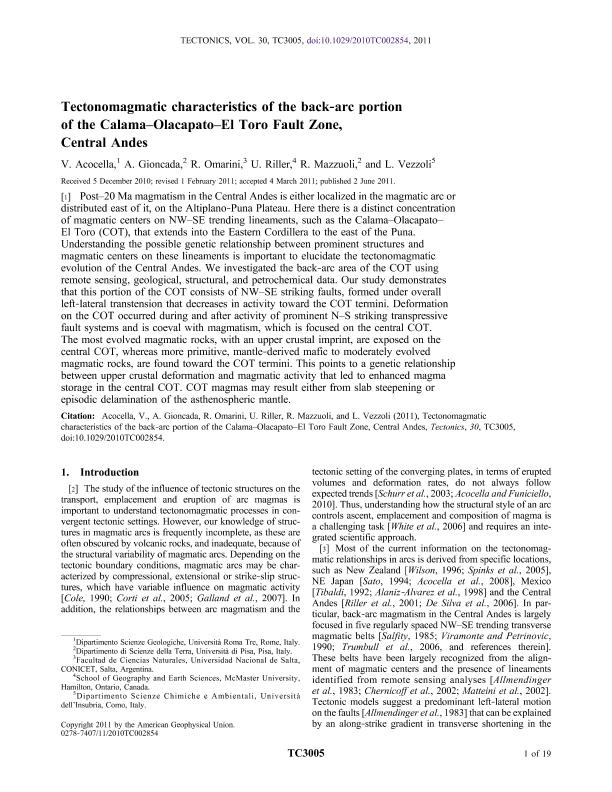Artículo
Tectonomagmatic characteristics of the back‐arc portion of the Calama–Olacapato–El Toro Fault Zone, Central Andes
Fecha de publicación:
06/2011
Editorial:
American Geophysical Union
Revista:
Tectonics
ISSN:
0278-7407
Idioma:
Frances
Tipo de recurso:
Artículo publicado
Clasificación temática:
Resumen
Post–20 Ma magmatism in the Central Andes is either localized in the magmatic arc or distributed east of it, on the Altiplano-Puna Plateau. Here there is a distinct concentration of magmatic centers on NW–SE trending lineaments, such as the Calama–Olacapato–El Toro (COT), that extends into the Eastern Cordillera to the east of the Puna. Understanding the possible genetic relationship between prominent structures and magmatic centers on these lineaments is important to elucidate the tectonomagmatic evolution of the Central Andes. We investigated the back-arc area of the COT using remote sensing, geological, structural, and petrochemical data. Our study demonstrates that this portion of the COT consists of NW–SE striking faults, formed under overall left-lateral transtension that decreases in activity toward the COT termini. Deformation on the COT occurred during and after activity of prominent N–S striking transpressive fault systems and is coeval with magmatism, which is focused on the central COT. The most evolved magmatic rocks, with an upper crustal imprint, are exposed on the central COT, whereas more primitive, mantle-derived mafic to moderately evolved magmatic rocks, are found toward the COT termini. This points to a genetic relationship between upper crustal deformation and magmatic activity that led to enhanced magma storage in the central COT. COT magmas may result either from slab steepening or episodic delamination of the asthenospheric mantle.
Palabras clave:
Tectonic
,
Volcanology
,
Central Andes
Archivos asociados
Licencia
Identificadores
Colecciones
Articulos(CCT - SALTA-JUJUY)
Articulos de CTRO.CIENTIFICO TECNOL.CONICET - SALTA-JUJUY
Articulos de CTRO.CIENTIFICO TECNOL.CONICET - SALTA-JUJUY
Citación
Acocella, V.; Gioncada, A.; Omarini, Ricardo Hector; Riller, U.; Mazzuoli, R.; et al.; Tectonomagmatic characteristics of the back‐arc portion of the Calama–Olacapato–El Toro Fault Zone, Central Andes; American Geophysical Union; Tectonics; 30; 3; 6-2011; 1-19; TC3005
Compartir
Altmétricas




